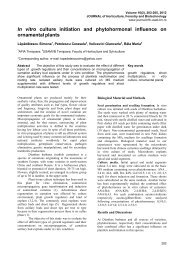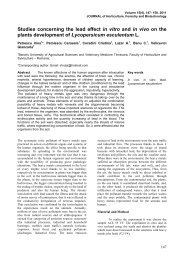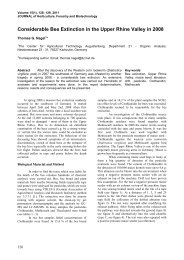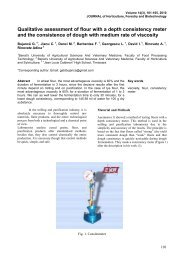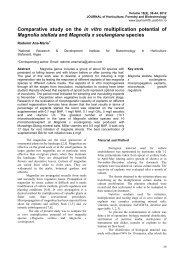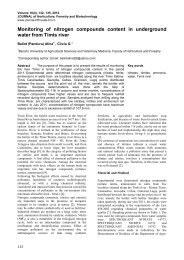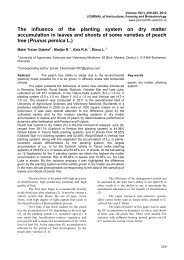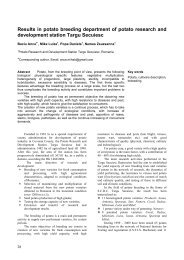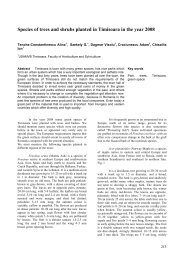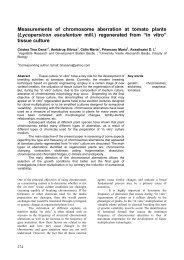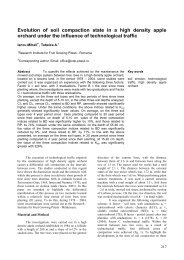Endophytic fungi from Vitis vinifera L. isolated in Canary Islands and ...
Endophytic fungi from Vitis vinifera L. isolated in Canary Islands and ...
Endophytic fungi from Vitis vinifera L. isolated in Canary Islands and ...
Create successful ePaper yourself
Turn your PDF publications into a flip-book with our unique Google optimized e-Paper software.
Evaluation of the genetically modified corn resistance to fungal<strong>in</strong>fectionPopescu Sor<strong>in</strong>a*, Ioja-Boldura Oana Maria** Banat University of Agricultural Sciences <strong>and</strong> Veter<strong>in</strong>ary Medic<strong>in</strong>e Timisoara, Romania*Correspond<strong>in</strong>g author. Email: biotehnologii_usab@yahoo.comAbstract The genus Fusarium has a global distribution <strong>and</strong> many species<strong>in</strong> the genus are phytopathogenic <strong>fungi</strong> <strong>in</strong>fect<strong>in</strong>g a wide range of crop plants<strong>in</strong>clud<strong>in</strong>g cereals such as maize, wheat, oat <strong>and</strong> barley. Insect pests of cornare often <strong>in</strong>volved <strong>in</strong> the disease cycles of ear rot <strong>and</strong> stalk rot diseases. TheEuropean corn borer is particularly well known for its <strong>in</strong>volvement <strong>in</strong> thesediseases. Bt corn is a variant of maize, genetically modified to express thebacterial Bt tox<strong>in</strong>, which protect the plants aga<strong>in</strong>st this pest, thereforereduc<strong>in</strong>g the <strong>in</strong>tensity of Fusarium contam<strong>in</strong>ation. PCR based methods weresuccessfully applied <strong>in</strong> the screen<strong>in</strong>g for identification of contam<strong>in</strong>ation withpathogenic <strong>fungi</strong> for the corn samples. 14 corn samples, GM <strong>and</strong>conventional were subjected to PCR screen<strong>in</strong>g <strong>in</strong> order to detect thepresence of three Fusarium species. The presence of Fusariun proliferatumwas not detected <strong>in</strong> the GM corn samples. All three tested Fusarium species,were found <strong>in</strong> the analyzed samples, <strong>in</strong> average conventional corn be<strong>in</strong>g themost affected.Key wordsBt corn, contam<strong>in</strong>ation,Fusarium ssp., detection,PCRFusarium stra<strong>in</strong> identification <strong>in</strong> complex feeds <strong>from</strong> RomanianmarketIoja-Boldura Oana Maria 1 , Popescu Sor<strong>in</strong>a 11 Banat University of Agricultural Sciences <strong>and</strong> Veter<strong>in</strong>ary Medic<strong>in</strong>e Timisoara*Correspond<strong>in</strong>g author. Email: biotehnologii_usab@yahoo.comAbstract Fusarium contam<strong>in</strong>ation is a major agricultural problem asquality <strong>and</strong> yield can be reduced, but more importantly many species <strong>in</strong> thegenus produce mycotox<strong>in</strong>s responsible for serious diseases <strong>in</strong> humans <strong>and</strong>farm animals. The most common mycotox<strong>in</strong>e <strong>in</strong> cereals is deoxynivalenol(DON) produced by certa<strong>in</strong> isolates of Fusarium spp., be<strong>in</strong>g prevalentworldwide <strong>in</strong> crops used for food <strong>and</strong> feed production. Identification ofFusarium species is critical to predict the potential mycotoxigenic risk of thecereals, therefore the development of an accurate <strong>and</strong> complementarymethod which permits a rapid, sensitive <strong>and</strong> reliable specific diagnosis ofFusarium species, is necessary. DNA based approaches applied <strong>in</strong> this studyhave been already reported as rapid, sensitive <strong>and</strong> specific alternatives toidentify the ma<strong>in</strong> trichothecene-produc<strong>in</strong>g Fusarium species. The biologicalmaterial consisted of eight samples of commercial feeds were all positive forFusarium species <strong>and</strong> therefore be<strong>in</strong>g suitable for further identification ofthose pathogenic organisms. In addition two of tox<strong>in</strong>s biosynthetic genes werealso detected. Therefore, this method proved to be suitable <strong>in</strong> screen<strong>in</strong>g offorage samples, <strong>in</strong> order to detect their contam<strong>in</strong>ation.Key wordsFusariumssp.,mycotox<strong>in</strong>es, feed products,screen<strong>in</strong>g, PCR



